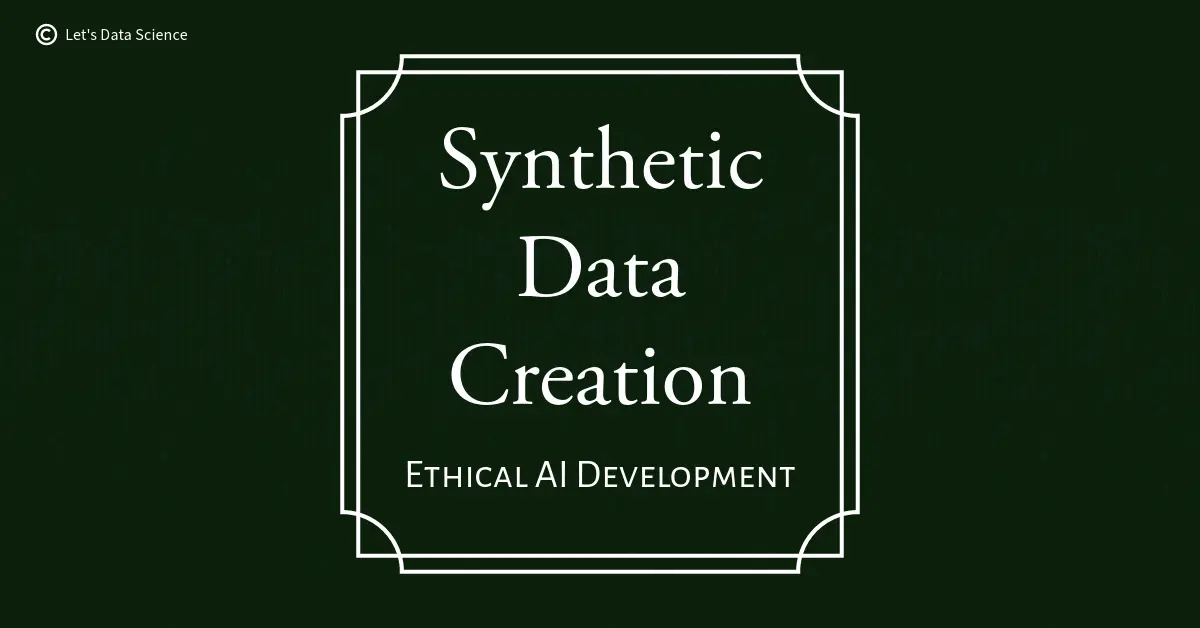Introduction
Imagine your AI could learn without limits. What if you could train it on anything – rare medical conditions, customer behavior before a product even launches, even a self-driving car’s reactions to the craziest events on the road? The catch? Real-world data for all of this is either impossible to get, insanely expensive, or raises privacy concerns.
That’s where synthetic data comes in. It’s like a key that unlocks your AI’s potential. Think of it as artificially made data that carefully mimics the real world – but without the usual hassles.
In this article, I’ll show you the power of synthetic data. We’ll cover what it is, why it’s awesome, and walk through creating your own using Python code. By the end, you’ll see how synthetic data can:
- Beat data shortages: Train your AI without needing massive real-world datasets.
- Protect privacy: No worries about using sensitive personal information.
- Supercharge training: Explore rare events and “what-if” scenarios your AI might never see otherwise.
Ready to break your AI free from data limitations? Let’s dive in!
The What and Why of Synthetic Data
What Exactly IS Synthetic Data?
Think of synthetic data as the “pretend” version of real-world data. It’s carefully crafted to be statistically similar to the stuff you’d collect from actual people, objects, or events, but it’s entirely computer-generated. This is NOT just randomly made-up numbers – it’s designed to have the same key patterns and characteristics as the real deal.
Why Synthetic Data is an AI Game-Changer
Here’s why this “data doppelganger” is so powerful:
- No More Data Shortages: What if you need thousands of medical scans for a rare disease or customer behavior data for a product that doesn’t even exist yet? Synthetic data makes it possible.
- Privacy Protection: Real customer or medical data is sensitive stuff. Synthetic data lets you train AI without those ethical headaches.
- Bias Buster: Real-world data is often biased (more men than women in a dataset, for example). Synthetic data lets you build balanced datasets that give your AI a fairer view.
- The “What-If” Trainer: Want your AI to handle weird and unpredictable situations? Synthetic data lets you generate all sorts of rare events and edge cases.

Source: Turing
Types of Synthetic Data at a Glance
Not all synthetic data is created equal! Here’s a quick rundown of the most common types:
- GANs (Generative Adversarial Networks): The masters of realistic images and other complex data.
- Procedural: Like following a recipe for data. Great for structured stuff like addresses or financial records.
- Simulation-based: Perfect for scenarios where physical rules matter, like training self-driving car AI.
Did You Know? Some of your favorite movie special effects use the same tech behind synthetic data to create realistic digital worlds!
Question to Ponder: What’s ONE data problem you face in your own AI projects that synthetic data might be able to solve?
Choose Your Synthetic Adventure
Your Data, Your Path
The best way to generate synthetic data depends entirely on what you want your AI to learn. Let’s say you’re working in one of these fields:
- Healthcare: Need more X-rays to detect a condition, but patient data is highly sensitive.
- Product Design: Have the 3D model of a new gadget, but want to see how customers would use it in thousands of settings.
- Self-Driving Cars: Your AI needs to react to crazy events (a deer leaping out!), but you can’t just wait for it to happen on a test drive.
Each of these calls for a different approach to synthetic data!
Your Synthetic Data “Cheat Sheet”
Here’s a breakdown of when to use which common techniques:
- GANs (Generative Adversarial Networks)
- Your Goal: Ultra-realistic visuals (medical images, new fashion products, faces for customer service chatbots)
- Real-World Case: Researchers used GANs to create synthetic brain scans, aiding in the early detection of diseases while protecting patient privacy.
- Procedural Generation
- Your Goal: Large sets of structured data (customer records, financial transactions, website user behavior logs)
- Real-World Case: E-commerce companies use procedural generation to test how website layout changes affect customer behavior, without needing real users during the experiment.
- Simulation-Based
- Your Goal: AI that reacts to a physics-based world (robotics, self-driving cars, game development)
- Real-World Case: Self-driving car companies train their AI in hyper-realistic simulation environments, including varied weather, lighting, and unpredictable deer!
The Power of Mixing Techniques
Sometimes, the best synthetic data comes from combining methods. Imagine you’re developing a video game with characters who have unique appearances and backgrounds. You could use:
- GANs to generate realistic faces
- Procedural generation to create stats, names, and life histories
Question to Ponder: If you HAD unlimited data, what kind of AI project would you tackle? This can hint at the perfect way to use synthetic data in your current work!
Generating Synthetic Data (Practical Python Time)
Understanding the ‘adult’ Dataset
Let’s get hands-on with generating synthetic data! It’s often easier to learn what it is through doing. To start, we’ll use a neat built-in dataset within the SDV library called ‘adult’. Let’s look at what it tells us:
import pandas as pd
from sdv.datasets.demo import download_demo
from sdv.single_table import CTGANSynthesizer
from sdv.metadata import SingleTableMetadata
# Get the demo data for our project
data, metadata = download_demo('single_table', dataset_name='adult')
print(data.head()) # Sneak peek at the first few rows
| age | workclass | fnlwgt | education | education-num | marital-status | occupation | relationship | race | sex | capital-gain | capital-loss | hours-per-week | native-country | label | |
| 0 | 27 | Private | 177119 | Some-college | 10 | Divorced | Adm-clerical | Unmarried | White | Female | 0 | 0 | 44 | United-States | <=50K |
| 1 | 27 | Private | 216481 | Bachelors | 13 | Never-married | Prof-specialty | Not-in-family | White | Female | 0 | 0 | 40 | United-States | <=50K |
| 2 | 25 | Private | 256263 | Assoc-acdm | 12 | Married-civ-spouse | Sales | Husband | White | Male | 0 | 0 | 40 | United-States | <=50K |
| 3 | 46 | Private | 147640 | 5th-6th | 3 | Married-civ-spouse | Transport-moving | Husband | Amer-Indian-Eskimo | Male | 0 | 1902 | 40 | United-States | <=50K |
| 4 | 45 | Private | 172822 | 11th | 7 | Divorced | Transport-moving | Not-in-family | White | Male | 0 | 2824 | 76 | United-States | >50K |
This dataset contains information like a person’s age, job, education level, and more. While not customer data, it has similar patterns – useful to learn the techniques involved!
Our Tool: The SDV Library
SDV (Synthetic Data Vault) is a fantastic Python toolkit specifically designed to help us generate new data like this. To keep things focused, we’re going to work with an SDV model called CTGAN. Under the hood, it learns patterns from our sample data to make new stuff!
Step-by-Step: Let the Generation Begin!
model = CTGANSynthesizer(metadata) # Create our SDV model
model.fit(data) # Teach it about the patterns in 'adult'
new_data = model.sample(1000) # Boom! Let's make 1000 new 'people'
Created Synthetic Data:
| age | workclass | fnlwgt | education | education-num | marital-status | occupation | relationship | race | sex | capital-gain | capital-loss | hours-per-week | native-country | label | |
| 0 | 27 | Private | 215961 | HS-grad | 9 | Married-civ-spouse | Other-service | Husband | White | Male | 20 | 0 | 49 | United-States | <=50K |
| 1 | 49 | Private | 80767 | 9th | 4 | Married-civ-spouse | Sales | Husband | White | Male | 28 | 0 | 40 | United-States | <=50K |
| 2 | 69 | Private | 188864 | Doctorate | 15 | Widowed | Sales | Not-in-family | White | Female | 3776 | 0 | 40 | United-States | <=50K |
| 3 | 28 | Private | 405696 | Doctorate | 16 | Never-married | Sales | Own-child | White | Female | 11 | 1 | 53 | England | <=50K |
| 4 | 43 | Self-emp-not-inc | 382373 | Assoc-acdm | 4 | Divorced | Machine-op-inspct | Not-in-family | White | Male | 0 | 0 | 49 | United-States | <=50K |
Behind the Code (In Plain English):
- Setting Up: We sort of ‘build’ our CTGAN model and explain its job is to find patterns in the dataset
- Learning Time: Think of
fitas your model studying the sample people carefully - Creative Burst:
samplesays “OK, show me what you learned – make some new data points that resemble the originals”
Things to Keep in Mind
- Patience: CTGAN might take a little while to think. Larger datasets get even trickier – that’s something important for readers to know!
- It’s Not Identical Copies: Synthetic data isn’t about getting the same rows again, but about making variations similar to what we ‘teach’ our model.
Next Up: Quality Check!
Just because we can create data doesn’t mean it’s perfect. In the next section, we’ll take our fancy tools from statistics and put this fresh, synthetic data to the test: Does it really mirror the trends and features of our original adult sample?
Google Colab Notebook:
Synthetic Data Checkup: Ensuring Quality
Generating gobs of synthetic data is exciting, but it’s not magic. Just like a delicious dish, the quality of your ingredients (here, the data itself) matters! This section equips you with tools to assess your synthetic data’s “goodness” before feeding it to your AI models.
Statistical Sleuthing
Imagine you have two bowls of candy: one real, one “synthetic.” By eye, they might look similar. However, a closer look (statistical analysis) can reveal hidden differences. Here’s how:
Means and Measures: Check if basic statistics like average age or income distribution in your synthetic data resemble the real dataset. For example, in our code, we calculated that the average “real age” was 38.58, while the synthetic data had an average age of 36.81. This isn’t a huge difference, but it’s good to be aware of.
import pandas as pd
# Grab some statistical measures from the original data
real_age_mean = data['age'].mean()
real_age_dist = data['age'].value_counts().sort_index()
# Compare them to the synthetic data
synth_age_mean = new_data['age'].mean()
synth_age_dist = new_data['age'].value_counts().sort_index()
# Print the results for easy comparison
print("Real age average:", real_age_mean)
print("Synthetic age average:", synth_age_mean)
print("Real age distribution:\n", real_age_dist)
print("Synthetic age distribution:\n", synth_age_dist)
Output:
Real age average: 38.58164675532078
Synthetic age average: 36.819
Distribution Detectives: Dive deeper with visualizations like histograms. Our plot showed the age distribution in both datasets. While the overall shapes were similar, the real data had more people in their 20s, while the synthetic data had slightly fewer.
import matplotlib.pyplot as plt
# Plot histograms of age distributions (real vs. synthetic) side-by-side
plt.figure(figsize=(10, 5))
plt.hist(data['age'], label='Real Data', alpha=0.7)
plt.hist(new_data['age'], label='Synthetic Data', alpha=0.7)
plt.legend()
plt.title('Age Distribution Comparison')
plt.show()

Real-World Relevance: Training and Evaluating a Mini Model
But can synthetic data actually “fool” an AI model? Let’s set up a mini-experiment. We trained a simple model to predict income level (>$50K or <=$50K) based on age and education in both the real and synthetic datasets. If the model performs similarly on both, it’s a positive sign!
import pandas as pd
from sklearn.model_selection import train_test_split
from sklearn.linear_model import LogisticRegression
from sklearn.metrics import accuracy_score
from sklearn.preprocessing import OrdinalEncoder
# Before the 'train_test_split'...
encoder = OrdinalEncoder()
# Step 1: Prep real data
X_real = data[['age', 'education']]
y_real = data['label']
X_real['education'] = encoder.fit_transform(data[['education']])
X_train_real, X_test_real, y_train_real, y_test_real = train_test_split(X_real, y_real, test_size=0.3)
# Step 2: Train a model on REAL data
model_real = LogisticRegression()
model_real.fit(X_train_real, y_train_real)
y_pred_real = model_real.predict(X_test_real)
accuracy_real = accuracy_score(y_test_real, y_pred_real)
# Step 3: Repeat for SYNTHETIC data
X_synth = new_data[['age', 'education']]
y_synth = new_data['label']
X_synth['education'] = encoder.transform(new_data[['education']])
X_train_synth, X_test_synth, y_train_synth, y_test_synth = train_test_split(X_synth, y_synth, test_size=0.3)
model_synth = LogisticRegression()
model_synth.fit(X_train_synth, y_train_synth)
y_pred_synth = model_synth.predict(X_test_synth)
accuracy_synth = accuracy_score(y_test_synth, y_pred_synth)
# Step 4: Compare!
print("Accuracy on real data: ", accuracy_real)
print("Accuracy on synthetic data: ", accuracy_synth)
Output:
Accuracy on real data: 0.7423482444467192 Accuracy on synthetic data: 0.8166666666666667
In our example, the accuracy on real data was 0.74, while the synthetic data achieved 0.82. This suggests the synthetic data captured the income-predicting patterns well, even exceeding real data accuracy in this case! However, remember, this is a simplified test, and more complex models often require more rigorous checks.
The Human Touch: Visual Inspection
Finally, unleash your human superpowers! Sometimes, subtle visual cues can expose synthetic data imperfections. For instance, in synthetic images, people might have strangely smooth skin or unrealistic hair. While AI is impressive, human intuition can still play a valuable role.
Remember
This checkup isn’t a one-time thing. As you refine your synthetic data generation process, revisit these checks and incorporate new ones specific to your use case. The goal is to build trust in your synthetic data, ensuring it empowers your AI models effectively.
Beyond the Code: Real-World Examples of Synthetic Data Checkup
Here are some inspiring ways different domains leverage synthetic data checkups:
- Self-driving cars: Testing how a car responds to rare or risky traffic scenarios (synthetically generated) helps ensure safety and robustness before real-world deployment.
- Financial fraud detection: Validating if synthetic financial transactions mimic real fraudulent patterns is crucial for training effective detection systems.
- Healthcare research: Checking if synthetic patient data preserves the privacy of sensitive medical information while maintaining key statistical properties is vital for ethical research practices.
The Synthetic Frontier: Where We’re Headed
We’ve seen synthetic data’s incredible potential. But like any tool, it has limits – which actually open up doors for even more innovation! Let’s glimpse the forefront of this evolving field.
Limitations and Hype: Not a Silver Bullet
- Quality Costs: Generating high-quality synthetic data, specifically for complex use cases, can still be computationally expensive and time-consuming.
- Beware of Hidden Bias: If your real-world dataset has biases, your synthetic data might unintentionally ‘learn’ and perpetuate those. Careful design and constant vigilance are necessary!
- The AI Knows: If your AI is only trained on synthetic data, it might struggle when presented with messy, real-world scenarios it never encountered during training.
Ethical Use: Responsibility Matters
- Deepfakes Done Right: Synthetic media (videos, audio) raise the stakes. It’s possible to generate content for artistic or historical purposes ethically, but it’s essential to always clearly distinguish synthetic creations from reality.
- Protecting People: While synthetic data removes privacy concerns from a direct data standpoint, the broader application must always strive to respect individuals. For example, could someone misuse realistic but synthetic financial records to harm others’ reputations?
The Future is Hybrid: The Best of Both Worlds
The most powerful AI will likely leverage a blend of real and synthetic data:
- Small but Precious: Sometimes, even a modest amount of real data acts as a “ground truth” anchor, enhancing vast quantities of synthetically expanded data.
- Learning to Adapt: Researchers are developing AI models that can adapt to new or even partially synthetic data sources on the fly, improving their handling of the unpredictable real world.
- Augmented Datasets: Real datasets can be improved by carefully injecting synthetic examples to balance their contents or fill in gaps caused by rare events.
Real-World Examples of Responsible Growth Frontiers
- Medicine Without Risk: Doctors train complex systems on synthetic medical data without ever jeopardizing patient privacy. Surgical simulations based on varied ‘synthetic patients’ could vastly improve skill acquisition.
- AI for Everyone: Smaller businesses or researchers without massive data might find pre-trained models on high-quality synthetic data a game-changer, democratizing AI use.
- Synthetic Advocacy: Could we create highly realistic simulations with synthetic ‘populations’ to test public policies before real-world rollout? Such scenarios, if transparent, have potential to guide evidence-based policymaking.
Conclusion
Synthetic data has unlocked massive potential for AI, with even greater breakthroughs ahead as the technology matures. By understanding its limitations, being transparent about its use, and focusing on real-world benefits, we forge a path toward more intelligent, data-driven solutions…both real and extraordinary!
Conclusion: Synthetic Data Unlocks AI’s Potential
We started with a frustration: powerful AI needs tons of data that’s often unavailable, sensitive, or costly. Synthetic data has emerged as a powerful solution, enabling us to overcome these limitations responsibly. While not a magical cure-all, its potential across fields is inspiring:
- Preserving Privacy: Real-world worries melt away when sensitive datasets can be transformed into realistic but non-identifiable synthetic ones.
- Fighting Bias: By deliberately crafting synthetic data, we can combat the real-world biases that seep into training.
- Exploring the “What If”: Generate those rare events your AI needs to be robust, without waiting for them to happen (hopefully never!) in the real world.
The Journey Goes On
Remember, generating good synthetic data is an iterative process. The quality checks we explored are your guiding star. Don’t fear mistakes – those teach us how to make our artificial data even more realistic and useful. And the most exciting part? Hybrid techniques mixing real and synthetic data are a booming frontier!
Your Turn to Innovate!
Whether you’re tackling healthcare challenges, creating better marketing campaigns, or something completely new, experimenting with synthetic data could spark incredible advances. As with any tool, responsible and ethical use is crucial. Ask yourself:
- How will you ensure fairness and privacy as you employ synthetic data?
- Can your project pave the way toward even better synthetic data tools in the future?
We’re on the cusp of an AI revolution powered by data that doesn’t have to be strictly “real.” I can’t wait to hear about the breakthroughs you make along the way!
Further Reading:
Documentation: Synthetic Data Vault
Research Paper: Generative Adversarial Nets
Research Paper: Deep Learning for Procedural Content Generation




